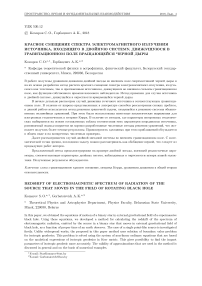Красное смещение спектра электромагнитного излучения источника, входящего в двойную систему, движущуюся в гравитационном поле вращающейся черной дыры
Автор: Комаров С.О., Горбацевич А.К.
Журнал: Пространство, время и фундаментальные взаимодействия @stfi
Рубрика: Гравитация, космология и фундаментальные поля
Статья в выпуске: 4 (25), 2018 года.
Бесплатный доступ
В работе получены уравнения движения двойной звезды во внешнем поле сверхмассивной черной дыры и на их основе разработан метод расчета красного смещение спектра электромагнитного излучения, излучаемого как точечным, так и протяженным источником, движущимся во внешнем сильном гравитационном поле, как функции собственного времени наземного наблюдателя. Метод применен для случая источника в двойной системе, движущейся в окрестности вращающейся черной дыры.В начале детально рассмотрен случай движения точечного источника в соответствующем гравитационном поле. В отличие от широко представленных в литературе способов рассмотрения схожих проблем, в данной работе используется метод решения граничной задачи, сводящейся к решению системы обыкновенных нелинейных уравнений. При этом были использованы известные аналитические выражения для изотропных геодезических в метрике Керра. В отличие от методов, где параметры изотропных геодезических выбираются на основе составленных таблиц соответствия этих параметров координатам источника, развиваемый подход опирается на хорошо разработанные численные методы решения уравнений, что позволяет получать более точные результаты...
Гравитационное красное смещение, метрика керра, уравнения движения в общей теории относительности
Короткий адрес: https://sciup.org/142221690
IDR: 142221690 | DOI: 10.17238/issn2226-8812.2018.4.57-69
Список литературы Красное смещение спектра электромагнитного излучения источника, входящего в двойную систему, движущуюся в гравитационном поле вращающейся черной дыры
- Gillessen S., Plewa P., Eisenhauer F., et. al. An update on monitoring stellar orbits in the galactic center. Astrophys. J. 2017; 837: S. 19.
- Mark R., Morris. The environment of the galaxy's central black hole. In The galactic black hole. Lectures on General Relativity and Astrophysics, edited by H. F. Falcke and F. W. Hehl. S. 95-122. Ltd 2003.
- Eisenhauer F., Genzel R., Gillessen S. The galactic center massive black hole and nuclear star cluster. Rev. Mod. Phys. 2010; 82: S. 3121-3195.
- Gillessen S., Eisenhauer F., Trippe S., et. al. Monitoring stellar orbits around the massive black hole in the galactic center. Astrophys. J. 2009; 692: S. 1075-1109.
- Youjun Lu, Fupeng Zhang, Qingjuan Yu. On testing the kerr metric of the massive black hole in the galactic center via stellar orbital motion: full general relativistic treatment. Astrophys. J. 2015; 809: S. 27.
- Paumard T., Grould M., Vincent F.H., Perrin G. General relativistic effects on the orbit of the s2 star with gravity. Astronomy and Astrophysics. 2017; 608: S. A60, 1-22.
- Psaltis D., Wex N., Kramer M. A quantitative test of the no-hair theorem with sgr A* using stars, pulsars, and the event horizon telescope. Astrophys. J. 2016; 818: S. 19.
- Fupeng Zhang, Prasenjit Saha. Probing the spinning of the massive black hole in the galactic center via pulsar timing: A full relativistic treatment. Astrophys. J. 2017; 849: S. 15.
- Hailey C.J., Mori K., Bauer F.E., et al. A density cusp of quiescent x-ray binaries in the central parsec of the galaxy. Nature (London). 2018; 556: S. 70-73.
- Gorbatsievich A., Bobrik A. The equations of motion of compact binaries in the neighbourhood of supermassive black hole. In The Sun, The Stars, The Universe and General Relativity: International Conference in Honor of Ya.B. Zeldovich's 95th Anniversary vol. 1205: S. 87-96. AIP 2010; - 691 0.1063/1.3382338.
- DOI: 10.17238/issn2226-8812.2018.4.57
- Stephani H. Relativity. An introduction to Special and General Relativity. Third English edition: "Cambridge University Press"; 2004.
- Komarov S., Gorbatsievich A., Tarasenko A. Redshift of a compact binary star in the neighborhood of a supermassive black hole. General Relativity and Gravitation. 2018; 50: S. 132.
- Ryuichi Fujita, Wataru Hikida. Analytical solutions of bound timelike geodesic orbits in kerr spacetime. arXiv:0906.1420v2. 2012.
- Chandrasechar S. The mathematical theory of black holes. New York: Oxford University press; 1983.
- Korn G.A., Korn T.M. Mathematical handbook for scientists and engineers; definitions, theorems and formulas; for reference and review. New York, San Francisco, Toronto, London, Sidney: McGraw-Hill Book company; 1968.
- Арнольд В. И. Обыкновенные дифференциальные уравнения. Издание четвертое, 368 с. Ижевск: Редакция журнала "Регулярная и хаотическая динамика"; 2000.
- Bisnovatyi-Kogan G.S., Tsupko Yu. Strong gravitational lensing by schwarzschild black holes. Astrophysics. 2008; 51: S. 99-111.
- Gorbatsievich A., Komarov S., Tarasenko A. Optical appearance of a compact binary system in the neighbourhood of supermassive black hole. arXiv:1702.08381. 2017;.
- Tarasenko A. Reconstruction of a compact object motion in the vicinity of a black hole by its electromagnetic radiation. Phys. rev. D. 2010; 81: S. 123005.
- Комаров С.О., Горбацевич А.К., Тарасенко А.Н. Красное смещение излучения точечного источника, движущегося в поле вращающейся черной дыры // Докл. Нац. акад. наук Беларуси. 2018. 62. №6. С. 668-673. References


